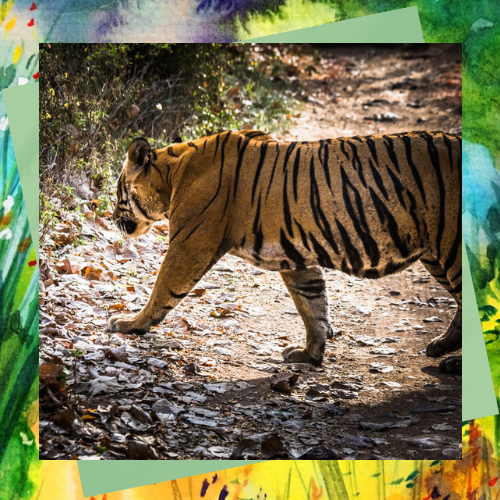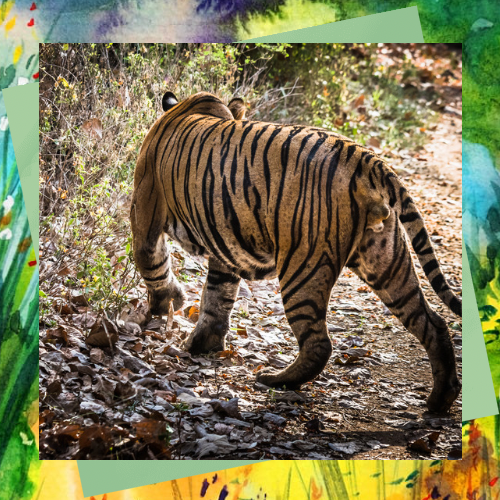Few tigers have captured the public’s imagination—and controversy—like T-24, better known as Ustad (“The Master”). A dominant male in India’s Ranthambore National Park, Ustad’s life was a mix of majesty, tragedy, and fierce debate over human-wildlife conflict. His story raises critical questions about conservation, ethics, and the blurred lines between protecting tigers and protecting people.


Ustad’s Rise to Fame
Born in 2005 to T20 (Jhumroo) and T22 (Gayatri), Ustad inherited the boldness of his legendary grandmother, Machali (T-16), Ranthambore’s most famous tigress. By 2010, he had claimed Zones 1, 2, and 6, ruling over 40 km² with unmatched confidence.
Unique Traits That Made Him a Star
- Fearless & Unconventional: Unlike most tigers, Ustad didn’t flee from humans. He’d drag his kills to roadsides, eating in plain view—a behavior that thrilled photographers but unnerved locals.
- A Swagger Like No Other: His imposing size (reportedly 258–270 kg) and regal demeanor earned him a massive fan following. Tourists flocked to Ranthambore just to see him.
- The “Popcorn-Smelling” Mark: Like all tigers, Ustad marked his territory with urine—which, oddly, smells like buttered popcorn due to a chemical compound called 2-AP.


The Turning Point: From King to “Man-Eater”
Ustad’s life took a dark turn when he was implicated in four human deaths between 2010–2015, including forest guard Rampal Saini in May 2015.
Why Did Ustad Turn Aggressive?
Experts speculate:
- Frequent Tranquilizations: He was sedated multiple times for medical treatments and radio-collar fittings, which may have altered his behavior.
- Disrupted Family Structure: Eight tigers from his clan were relocated, possibly increasing stress.
- Human Encroachment: The area where he hunted was near a temple and fort, meaning constant human presence.
Despite protests that the killings were accidental or provoked, the Rajasthan Forest Department declared him a “man-eater” and moved him to Sajjangarh Biological Park, a small enclosure in Udaipur .
The Great Ustad Debate: Conservation vs. Public Safety*
Ustad’s relocation sparked nationwide outrage:
- Social Media Campaigns: Fans demanded his return, arguing he was a victim of tourism pressure and poor management.
- Court Battles: Petitions reached the Supreme Court, but the Jaipur High Court upheld his captivity in 2015.
- Wildlife Experts Divided: Some, like Valmik Thapar, supported removal, citing clear danger. Others blamed human encroachment for provoking him.


Life in Captivity & Legacy
Confined to a 1-hectare enclosure (vs. his former 5,000-hectare domain), Ustad’s health declined. He suffered from megacolon and later bone cancer, passing away in December 2022.
Fun Facts About Ustad & Tigers
- Tigers Have Striped Skin: If shaved, their skin still shows stripes.
- They Can’t Purr: Unlike domestic cats, tigers show happiness by squinting or closing their eyes.
- A Punch Stronger Than Mike Tyson’s: One swipe can crush bones.


Lessons From Ustad’s Story
- Tourism vs. Conservation: Should wildlife reserves prioritize tigers or tourists? Ustad’s case showed the risks of habituating tigers to humans.
- Ethical Relocation: Was captivity the only solution? Some argue better patrolling or buffer zones could’ve prevented conflict.
- Public Role in Conservation: Social media activism can influence policy—but should science or sentiment guide decisions?
Ustad’s tale remains a cautionary reminder: As humans encroach further, will there be space left for tigers to truly be wild?
References
- The Hindu – T-24, the tiger in the news. https://www.thehindu.com/opinion/op-ed/ranthambore-tiger-reserve-t24-the-tiger-in-the-news/article7404504.ece
- Ranthambore National Park – Ustad’s Story. https://www.ranthamborenationalpark.in/tiger-t24-ustad.html
- Ranthambore.com – T-24’s Life. https://www.ranthamborenationalpark.com/t-24-tiger-ranthambore.html
- Ranthambore India – Ustad’s Profile. https://ranthamborenationalpark-india.com/t-24-ustad/
- Tiger 24 Documentary. https://t24movie.com/
- About Zoos – Ustad’s Relocation. https://aboutzoos.info/blog/970-tiger-t-24-in-india-s-ranthambore-tiger-reserve-killed-again-and-is-now-expelled
- WWF – Tiger Conservation. https://www.worldwildlife.org/species/tiger
- The Fact File – Tiger Facts. https://thefactfile.org/facts-about-tigers/
- The Indian Express – Ustad’s Health in Captivity. https://indianexpress.com/article/india/india-news-india/t-24-in-captivity-tiger-ustad-unwell-to-stay-at-sajjanpur-park/





